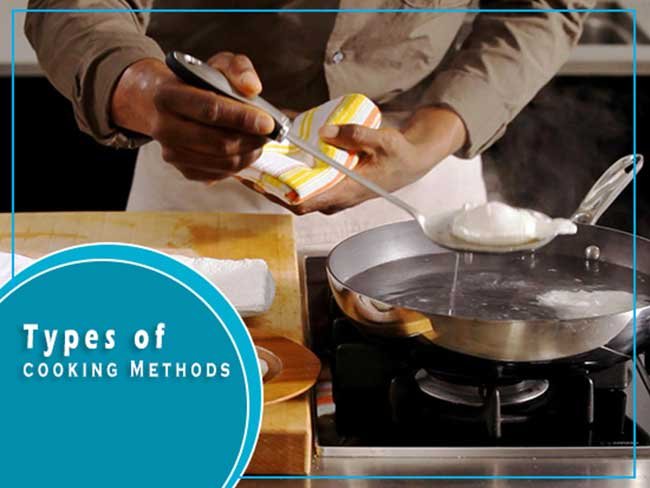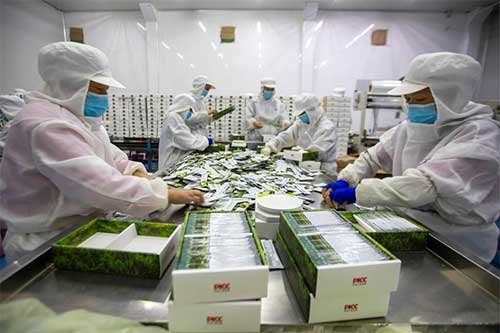
Types of Cooking Methods: There are many techniques for applying heat to foods. The method used depends a great deal on whether the food item is tough or tender.
If the item is tough, a long-time cooking method is selected to make the item more palatable and digestible.
If the item is tender, quick types of cooking methods are chosen for the best result.
To have a knowledge and understanding of the methods of cookery and to be aware of the simple scientific, artistic, and commercial implications to be considered regarding food preparation.

What is the Objective of Cooking Foods?
The objective of cooking food is to make it pleasing to the eye and reception to the palate to help stimulate the digestive juices thereby creating an appetite, to render food more digestive by physical and chemical changes and by alteration of the texture.
Thereby assisting mastication and ensuring the destruction of harmful and parasites.
Read More: Kitchen Safety Tips for the Food Industry: Chefs Should Not Skip this!
Types of Cooking Methods:
1. Boiling
2. Poaching
3. Steaming
4. Stewing
5. Braising
6. Roasting (Pot Roast, Oven Roast)
7. Grilling
8. Baking
9. Frying (Deep & Shallow)
10. Sauté
11. Blanching
12. Microwave
Boiling
Boiling is a type of cooking method to cook foods in a liquid. Usually stock or water.
The temperature at which boiled food is cooked is controlled by the temperature of the boiling liquid, and this temperature will not increase once the boiling point is reached therefore simmering (gentle boiling) should be allowed to take place.
Poaching
Poaching is a method of cooking foods slowly in the minimum amount of liquid, e.g., water, milk, stock, wine.
The liquid should never allow boiling but should be kept at a temperature as near to boiling level as possible.
As the foods are cooked in a minimum quantity of liquid to conserve flavor and nutritional value they should be covered with paper during the cooking to poach correctly and to prevent the food from boiling.
It is good practice to bring the liquid almost to a boil on top of the stove than to complete the cooking in a moderately hot oven.
Steaming
Steaming is a method of cooking in moist heat which can be:
• Slower than boiling in its simplest form
• Faster than by boiling as in a steamer with a minimum pressure of 1¼ kg/cm or a high compression steamer.
Stewing
This is the slow cooking of food in the smallest quantity of water.
Stock or sauce in which the food is always cut up and the food and cooking liquid are served together stewing is both economical and nutritional because the cheaper cuts of poultry and meat, which wouldn’t be suitable for grilling and roasting can be made palatable and tender and there is very little waste by evaporation.
The meats juices which escape from the meat during cooking are not lost but are present in the liquid which is served with the stew.
Read More: Kitchen Organization: Understanding the Modern Kitchen Brigade System
Braising
This is a combination of roasting and stewing in a pan with a tight-fitting lid. The lid is essential to prevent evaporation and to enable the food not only to retain its juices.
But also the flavors of the commodities are included for flavoring, e.g., bacon, ham, vegetables, herbs, etc.
Braising is a long slow method of cooking. Therefore, less tender joints of meat and poultry can be used.
Some recipes, particularly those using non-fatty joints, (venison, lean, beef) require the food to be marinated in red wine, vegetables, and herbs for a few hours before being cooked.
Roasting (Pot Roast & Oven Roast)
This is cooking by radiant (Direct) heat with the aid of fat in the form of basting every 20-30 min. Roasting may be carried out in two ways:
• On a constantly revolving spit in front of a clear bright fire into the open air or
• A heating element in the kitchen with a metal screen behind to reflect the heat.
Baking
Baking is a method of cookery applied by dry radiant heat in an oven in which the action of the dry heat is adjusted by steam. This steam arises from the water content of the food being baked.
Almost all bakery products are cooked by this method, and a considerable number of sweet and pastry dishes are either baked, or else part cooked on stone and finished in the oven.
Grilling or Broiling
This is a very quick method of cooking as the high degree of radiant or direct heat used can be maintained throughout the cooking. Grilled foods can be cooked-
Overheat – Charcoal, gas, electric
Under heat – Gas or electric, salamander or grill
Between Heat – Electrically heated grill bars
Frying
Frying is the cooking of food in heated oil or fat, which may be either shallow or deep.
Shallow Frying: When a small amount of oil/fat is used in frying, it knows as shallow frying, e.g., Fish Meunière.
Deep Frying: To cook in a higher amount of fat/oil using high heat.
The food is totally immersed in the oil. Normal frying temperature varies from 1600-1800C.frying is the quickest method of cooking because fats and oils can be raised to a very high temperature without during.
Food in direct contact with the oil is therefore rapidly heated and cooked but is unsuitable for tough meat and poultry.
Read More: Understanding a Daily Routine of Personal Hygiene in the Food Industry
Sauteing:
Sauteing is a Types of Cooking Methods. To fry lightly and quickly in a small amount of fat, turning the food frequently.
Blanching
It is a process of cooking food partially in hot fat or steam or boiling water.
Vegetables, fruits, and nuts are blanched in boiling water to remove their skins, to remove flavors, to inactivate enzymes or to shrink the foods before canning.
Microwave Cooking
Microwave energy is a high-frequency power.
It is similar to the energy which carries radio and television signals from the broadcast transmitter to receiver, but it operates at much higher frequencies in a television set the cathode ray tube helps project an image onto the screen in a microwave oven it is a tube called a magnetron which generates microwaves.
Microwaves may be: a) Transmitted through the air and various materials, e.g., glass, ceramics paper, and types of plastic b) Reflected by metal objects and utensils, e.g., silver dish. Cutlery foils containers and c) absorbedly food and items containing water.








